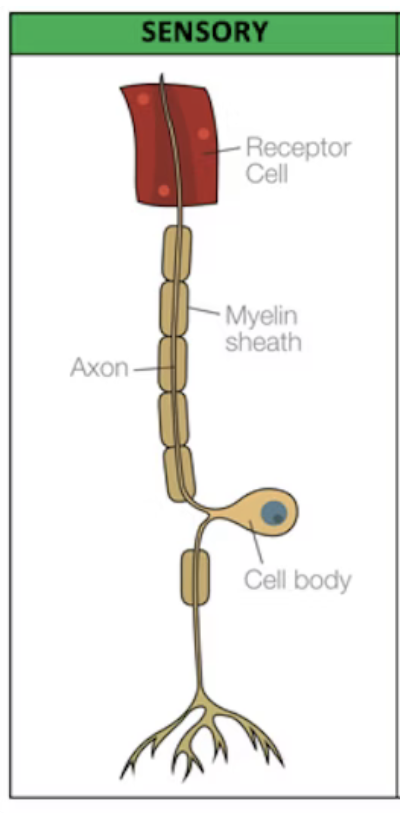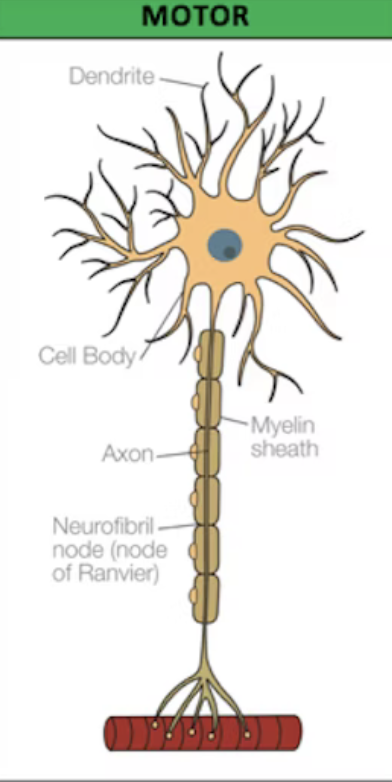CNS, PNS and endocrine system
1/15
There's no tags or description
Looks like no tags are added yet.
Name | Mastery | Learn | Test | Matching | Spaced |
|---|
No study sessions yet.
16 Terms
central nervous system (CNS)
main control system for life functions, plus conscious psychological processes - makes decisions
spinal cord
transmits information between the brain and peripheral nervous system
the spinal cord is a bundle of nerves, which runs from your brain along a canal in your backbone. its main function is to send nerve signals from the brain to the body, and from the body to the brain. it is also involved in reflex actions, such as the startle response. the brain is connected to the spinal cord by the brain stem
brain
higher psychological processes and regulates bodily processes based on information from peripheral nervous system - makes decisions
the brains outer layer, the cerebral cortex is highly developed in humans, it is made up of highly folded gray matter which makes up the outer layer of the brain. it is involved in a variety of higher cognitive (conscious thought), emotional, sensory (5 senses), and motor (movement) functions
the brain is divided into two symmetrical hemispheres: left (language, the ‘rational’ half of the brain, associated with analytical thinking and logical abilities) and right (involved with musical and artistic abilities). these are further divided up into four distinct lobes, the frontal lobe, parietal lobe, occipital lobe and temporal lobe. under the cerebral cortex is the area of the brain which is more primitive and are concerned with vital functioning and instinctive behaviour
peripheral nervous system (PNS)
transmits information between the central nervous system and external world/organs - sends this info to the CNS or takes commands from CNS and sends to muscles or glands
autonomic
transmits information between organs and CNS, responsible for involuntary bodily activities (e.g. heart rate)
somatic
transmits information between senses and CNS, directs voluntary movement (e.g. walking)
sympathetic
increases bodily functions to prepare for action (fight or flight)
parasympathetic
decreases bodily functions to conserve energy (calm and rest)
what are neurons
neurons are nerve cells that receive information and transmit it to other neuron’s. this ‘communication’ is done electrically and chemically. there are three types of neurons: sensory, motor and relay which typically consist of a cell body, dendrites and an axon but each type has a unique structure related to its function within the nervous system.
how do neurons work?
electrochemical messages or nerve impulses arrive at the neuron through the dendrites. the axon is like a long motorway, carrying the signal away from the cell body. some neurons have a myelin sheath around the axons. myelin is a fatty substance surrounding the axon cable and its function is to help speed ip the rate at which the nerve impulses are passed along the axon. when an impulse reaches the end of the axon it is passed onto another neutron, gland or organ via the axon terminals. neurotransmitters are the chemicals that pass from one neruon to another to pass the signal being transmitted.
sensory neurons
are located in the peripheral nervous system (PNS) respond to simulation in sensory receptors. they send signals to the central nervous system - spinal cord and brain - about this sensory experience. there are sensory neurone for all senses. most sensory neurons have long dendrites and short axons. sensory neurons carry signals away from the organ to the brain and spinal cord

motor neurons
cells in the PNS that send messages from the brain and the spinal cord to the muscles and glands. these usually have long axons and short dendrites. they help to produce a movement or a response

relay neurons
form connections between other neurons. they can send signals to other relay neurons or form links between sensory and motor neurons. all neurons in the CNS are relay neurons, and there are over 100 billion relay neurons
myelin sheath
many neurons outside the CNS are myelinated. myelin is rich in lipid and creates an electrically insulate layer around the axon that helps to increase the speed at which impulses travel.
the endocrine system
the endocrine system is a network of glands across the body that secrete chemical messengers called hormones
hypothalamus - connected to the pituitary gland and it stimulates and controls the release of hormones from the pituitary gland
pituitary gland - TSH and ACTH - the ‘master gland’ as it controls all other glands, for example TSH signals action in the thyroid and ACTH signals action in the adrenal gland
thyroid gland - thyroxine - primarily involved with the regulation of metabolism, such as the conversion of food into energy for the muscles
parathyroid gland - parathyroid hormone - PTH essentially acts to increase the concentration of calcium in the blood from kidneys to bone
pancreas - insulin - promotes the absorption of glucose from the blood into fat, liver and skeletal muscle cells. insulin lowers blood glucose levels
adrenal glands - adrenaline and noradrenaline - responsible for reacting to threat via the fight or flight response
ovaries - oestrogen and progesterone - responsible for the development and regulation of the female reproductive system and secondary sex characteristics
testes - testosterone - a key role in the development of male reproductive system such as the testes and prostate as well as promoting secondary sexual characteristics such as increased muscle and bone mass, and the growth of body hair
pineal gland - melatonin - regulates the sleep-wake cycle
fight or flight - how does the autonomic nervous system react to threat
the threat is detected by sensors (eye) and passed to the pituitary gland. the pituitary gland releases ACTH which is detected by the cells in the adrenal gland. this causes the adrenal gland to release adrenaline which causes heart rate to increase blood to vital organs, the stomach to divert blood to the muscles to increase strength, the pupils to dilate for increased vision and the lungs to increase breathing rate for more oxygen
parasympathetic response: after a few minutes, the parasympathetic branch of the ANS is activated and the body returns to normal by establishing homeostasis. heart rate and respiratory rate decrease, adrenaline secretion slows down, the feeling od butterflies subsides and sweating stops.